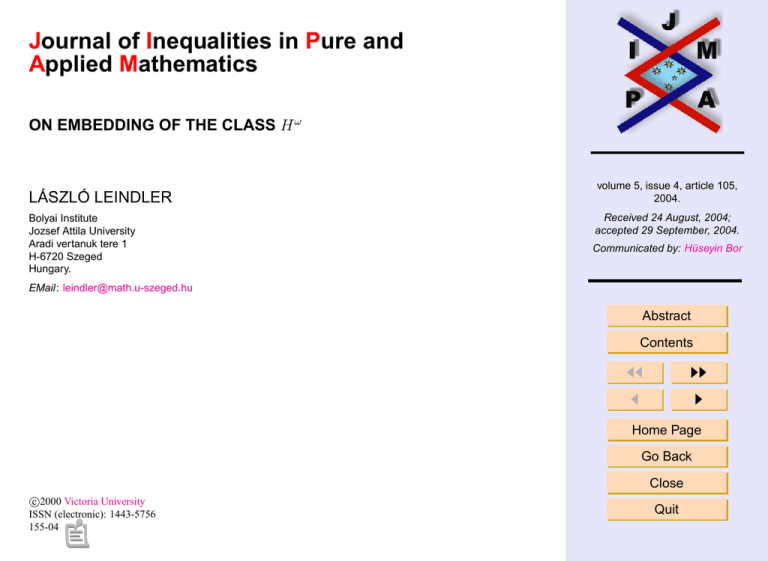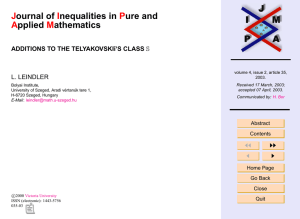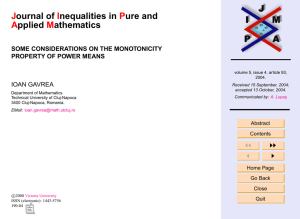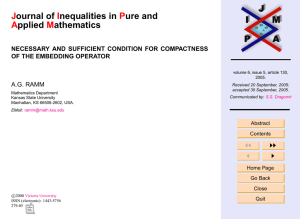J I P A
advertisement

Journal of Inequalities in Pure and
Applied Mathematics
ON EMBEDDING OF THE CLASS H ω
LÁSZLÓ LEINDLER
Bolyai Institute
Jozsef Attila University
Aradi vertanuk tere 1
H-6720 Szeged
Hungary.
volume 5, issue 4, article 105,
2004.
Received 24 August, 2004;
accepted 29 September, 2004.
Communicated by: Hüseyin Bor
EMail: leindler@math.u-szeged.hu
Abstract
Contents
JJ
J
II
I
Home Page
Go Back
Close
c
2000
Victoria University
ISSN (electronic): 1443-5756
155-04
Quit
Abstract
In [4] we extended an interesting theorem of Medvedeva [5] pertaining to the
embedding relation H ω ⊂ ΛBV, where ΛBV denotes the set of functions of
Λ-bounded variation, which is encountered in the theory of Fourier trigonometric series. Now we give a further generalization of our result. Our new theorem tries to unify the notion of ϕ-variation due to Young [6], and that of the
generalized Wiener class BV (p(n) ↑) due to Kita and Yoneda [3]. For further
references we refer to the paper by Goginava [2].
On Embedding of the Class H ω
László Leindler
2000 Mathematics Subject Classification: 26A15, 26A21, 26A45.
Key words: Embedding relation, Bounded variation, Continuity.
Title Page
The author was partially supported by the Hungarian National Foundation for Scientific Research under Grant No. T 042462, and TS 44782.
Contents
JJ
J
Contents
1
Introduction . . . . . . . . . . . . . . . . . . . . . . . . . . . . . . . . . . . . . . . . .
2
Results . . . . . . . . . . . . . . . . . . . . . . . . . . . . . . . . . . . . . . . . . . . . .
3
Lemmas . . . . . . . . . . . . . . . . . . . . . . . . . . . . . . . . . . . . . . . . . . . .
4
Proof of Theorem 2.1 . . . . . . . . . . . . . . . . . . . . . . . . . . . . . . . . .
References
3
6
7
9
II
I
Go Back
Close
Quit
Page 2 of 11
J. Ineq. Pure and Appl. Math. 5(4) Art. 105, 2004
http://jipam.vu.edu.au
1.
Introduction
Let ω(δ) be a nondecreasing continuous function on the interval [0, 1] having
the following properties:
ω(0) = 0, ω(δ1 + δ2 ) ≤ ω(δ1 ) + ω(δ2 ) for 0 ≤ δ1 ≤ δ2 ≤ δ1 + δ2 ≤ 1.
Such a function is called a modulus of continuity, and it will be denoted by
ω(δ) ∈ Ω.
The modulus of continuity of a continuous function f will be denoted by
ω(f ; δ), that is,
ω(f ; δ) := sup |f (x + h) − f (x)|.
On Embedding of the Class H ω
László Leindler
0≤h≤δ
0≤x≤1−h
As usual, set
Title Page
H ω := {f ∈ C : ω(f ; δ) = O(ω(δ))}.
α
If ω(δ) = δ α , 0 < α ≤ 1 we write H α instead of H δ .
Finally we define a new class of real functions f : [0, 1] → R. For every
k ∈ N let ϕk : [0, ∞) → R be a nondecreasing function with ϕk (0) = 0; and
let Λ := {λk } be a nondecreasing sequence of positive numbers such that
∞
X
1
= ∞.
λ
k
k=1
If a function f : [0, 1] → R satisfies the condition
(1.1)
sup
N
X
k=1
ϕk (|f (bk ) − f (ak )|)λ−1
k < ∞,
Contents
JJ
J
II
I
Go Back
Close
Quit
Page 3 of 11
J. Ineq. Pure and Appl. Math. 5(4) Art. 105, 2004
http://jipam.vu.edu.au
where the supremum is extended over all systems of nonoverlapping subintervals (ak , bk ) of [0, 1], then f is said to be of Λ{ϕk }-bounded variation, and this
fact is denoted by f ∈ Λ{ϕk }BV. In the special cases when all ϕk (x) = ϕ(x),
we write f ∈ Λϕ BV (see [4]), and if ϕ(x) = xp we use the notation f ∈ Λp BV,
and when p = 1, simply f ∈ ΛBV (see [5]). In the case λk = 1 and
ϕk (x) = ϕ(x) for all k, then we get the class Vϕ due to Young [6], finally if
λk = 1 and ϕk (x) = xpk , pk ↑, we get a class similar to BV (p(n) ↑) (see [3]).
Medvedeva [5] proved the following useful theorem, among others.
Theorem 1.1. The embedding relation H ω ⊂ ΛBV holds if and only if
∞
X
László Leindler
ω(tk )λk−1
<∞
k=1
Title Page
for any sequence {tk } satisfying the conditions:
(1.2)
On Embedding of the Class H ω
tk ≥ 0,
∞
X
tk ≤ 1.
k=1
In the sequel, the fact that a sequence t := {tk } has the properties (1.2) will
be denoted by t ∈ T. K and Ki will denote positive constants, not necessarily
the same at each occurrence.
Among others, in [4] we showed that if 0 < α ≤ 1 and pα ≥ 1 then
H α ⊂ Λp BV always holds, furthermore that if 0 < p < 1/α, then H α ⊂ Λp BV
is fulfilled if and only if for any t ∈ T,
∞
X
k=1
−1
tαp
k λk < ∞.
Contents
JJ
J
II
I
Go Back
Close
Quit
Page 4 of 11
J. Ineq. Pure and Appl. Math. 5(4) Art. 105, 2004
http://jipam.vu.edu.au
If ω(δ) is a general modulus of continuity then for 0 < p < 1 we verified
that H ω ⊂ Λp BV holds if and only if for any t ∈ T
(1.3)
∞
X
ω(tk )p λ−1
k < ∞.
k=1
These latter two results are immediate consequences of the following theorem of [4].
Theorem 1.2. Assume that ϕ(x) is a function such that ϕ(ω(δ)) ∈ Ω. Then
H ω ⊂ Λϕ BV holds if and only if for any t ∈ T
∞
X
ϕ(ω(tk ))λ−1
k < ∞.
k=1
Remark 1.1. It would be of interest to mention that by Theorem 1.2 the restriction 0 < p < 1 claimed above, can be replaced by the weaker condition
ω(δ)p ∈ Ω, and then the embedding relation H ω ⊂ Λp BV also holds if and
only if (1.3) is true.
On Embedding of the Class H ω
László Leindler
Title Page
Contents
JJ
J
II
I
Go Back
Close
Quit
Page 5 of 11
J. Ineq. Pure and Appl. Math. 5(4) Art. 105, 2004
http://jipam.vu.edu.au
2.
Results
Our new theorem tries to unify and generalize all of the former results.
Theorem 2.1. Assume that ω(t) ∈ Ω and for every k ∈ N, ϕk (ω(δ)) ∈ Ω. Then
the embedding relation H ω ⊂ Λ{ϕk }BV holds if and only if for any t ∈ T
∞
X
(2.1)
ϕk (ω(tk ))λ−1
k < ∞.
k=1
On Embedding of the Class H ω
Our theorem plainly yields the following assertion.
Corollary 2.2. If for all k ∈ N, pk > 0 and ω(δ)pk ∈ Ω, that is, if ϕk (x) = xpk ,
then H ω ⊂ Λ{xpk }BV holds if and only if for any t ∈ T
∞
X
(2.2)
László Leindler
Title Page
Contents
ω(tk )pk λ−1
k
< ∞.
k=1
It is also obvious that if ω(δ) = δ α , 0 < α ≤ 1, then (2.1) and (2.2) reduce to
JJ
J
II
I
Go Back
∞
X
k=1
respectively.
ϕk (tαk )λ−1
k < ∞ and
∞
X
k=1
k −1
tαp
k λk < ∞,
Close
Quit
Page 6 of 11
J. Ineq. Pure and Appl. Math. 5(4) Art. 105, 2004
http://jipam.vu.edu.au
3.
Lemmas
In the proof we shall use the following three lemmas.
Lemma 3.1 ([1, p. 78]). If ω(δ) ∈ Ω then there exists a concave function ω ∗ (δ)
such that
ω(δ) ≤ ω ∗ (δ) ≤ 2ω(δ).
Lemma 3.2. If ω(δ) ∈ Ω and t = {tk } ∈ T, then there exists a function f ∈ H ω
such that if
t1
x0 = 0, x1 = ,
2
n
X
tn+1
x2n =
ti and x2n+1 = x2n +
, n ≥ 1,
2
i=1
László Leindler
Title Page
Contents
then
f (x2n ) = 0 and f (x2n+1 ) = ω(tn+1 ) for all n ≥ 0.
A concrete function with these properties is given in [5].
Lemma 3.3. If ω(t) ∈ Ω and for all k ∈ N, ϕk (ω(t)) ∈ Ω also holds, furthermore for any t ∈ T the condition (2.1) stays, then there exists a positive number
M such that for any t ∈ T
(3.1)
On Embedding of the Class H ω
∞
X
ϕk (ω(tk ))λ−1
k ≤ M
JJ
J
II
I
Go Back
Close
Quit
Page 7 of 11
k=1
J. Ineq. Pure and Appl. Math. 5(4) Art. 105, 2004
holds.
http://jipam.vu.edu.au
Proof of Lemma 3.3. The proof follows the lines given in the proof of Theorem
2 emerging in [5]. Without loss of generality, due to Lemma 3.1, we can assume
that, for every k, the functions ϕk (ω(δ)) are concave moduli of continuity.
Indirectly, let us suppose that there is no number M with property (3.1).
Then for any i ∈ N there exists a sequence t(i) := {tk,i } ∈ T such that
i
2 <
(3.2)
∞
X
ϕk (ω(tk,i ))λ−1
k < ∞.
k=1
Now define
tk :=
∞
X
i=1
On Embedding of the Class H ω
tk,i
.
2i
László Leindler
It is easy to see that t := {tk } ∈ T, and thus (2.1) also holds.
Since every ϕk (ω(ω)) is concave, thus by Jensen’s inequality, we get that
!!
∞
∞
X
X
tk,i
ϕk (ω(tk,i ))
≥
.
(3.3)
ϕk (ω(tk )) = ϕk ω
i
i
2
2
i=1
i=1
Employing (3.2) and (3.3) we obtain that
∞
∞
∞
X
X
X
−1
−1
ϕk (ω(tk ))λk ≥
λk
ϕk (ω(tk,i ))2−i
k=1
=
k=1
∞
X
i=1
and this contradicts (2.1).
This contradiction proves (3.1).
−i
2
i=1
∞
X
Title Page
Contents
JJ
J
II
I
Go Back
Close
Quit
ϕk (ω(tk,i ))λ−1
k
= ∞,
Page 8 of 11
k=1
J. Ineq. Pure and Appl. Math. 5(4) Art. 105, 2004
http://jipam.vu.edu.au
4.
Proof of Theorem 2.1
Necessity. Suppose that H ω ⊂ Λ{ϕk }BV, but there exists a sequence t =
{tk } ∈ T such that
∞
X
(4.1)
ϕk (ω(tk ))λ−1
k = ∞.
k=1
Then, applying Lemma 3.2 with this sequence t = {tk } ∈ T and ω(δ), we
obtain that there exists a function f ∈ H ω such that
On Embedding of the Class H ω
|f (x2k−1 ) − f (x2k−2 )| = ω(tk ) for all k ∈ N.
László Leindler
Hence, by (4.1), we get that
N
X
ϕk (|f (x2k−1 ) −
f (x2k−2 )|)λ−1
k
=
k=1
N
X
Title Page
ϕk (ω(tk ))λ−1
k
→ ∞,
k=1
that is, (1.1) does not hold if bk = x2k−1 and ak = x2k−2 , thus f does not belong
to the set Λ{ϕk }BV.
This and the assumption H ω ⊂ Λ{ϕk }BV contradict, whence the necessity
of (2.1) follows.
Sufficiency. The condition (2.1), by Lemma 3.3, implies (3.1). If we consider a
system of nonoverlapping subintervals (ak , bk ) of [0, 1] and take tk := (bk −ak ),
then t := {tk } ∈ T, consequently for this t (3.1) holds. Thus, if f ∈ H ω , we
always have that
N
X
k=1
ϕk (|f (bk ) −
f (ak )|)λ−1
k
≤K
N
X
k=1
ϕk (ω(bk − ak ))λ−1
k ≤ KM,
Contents
JJ
J
II
I
Go Back
Close
Quit
Page 9 of 11
J. Ineq. Pure and Appl. Math. 5(4) Art. 105, 2004
http://jipam.vu.edu.au
and this shows that f ∈ Λ{ϕk }BV.
The proof is complete.
On Embedding of the Class H ω
László Leindler
Title Page
Contents
JJ
J
II
I
Go Back
Close
Quit
Page 10 of 11
J. Ineq. Pure and Appl. Math. 5(4) Art. 105, 2004
http://jipam.vu.edu.au
References
[1] A.V. EFIMOV, Linear methods of approximation of continuous periodic
functions, Mat. Sb., 54 (1961), 51–90 (in Russian).
[2] U. GOGINAVA, On the approximation properties of partial sums of trigonometric Fourier series, East J. on Approximations, 8 (2002), 403–420.
[3] H. KITA AND K. YONEDA, A generalization of bounded variation, Acta
Math. Hungar., 56 (1990), 229–238.
[4] L. LEINDLER, A note on embedding of classes H ω , Analysis Math., 27
(2001), 71–76.
[5] M.V. MEDVEDEVA, On embedding classes H ω , Mat. Zametki, 64(5)
(1998), 713–719 (in Russian).
[6] L.C. YOUNG, Sur une généralization de la notion de variation de Wiener et
sur la convergence des séries de Fourier, C.R. Acad. Sci. Paris, 204 (1937),
470–472.
On Embedding of the Class H ω
László Leindler
Title Page
Contents
JJ
J
II
I
Go Back
Close
Quit
Page 11 of 11
J. Ineq. Pure and Appl. Math. 5(4) Art. 105, 2004
http://jipam.vu.edu.au






